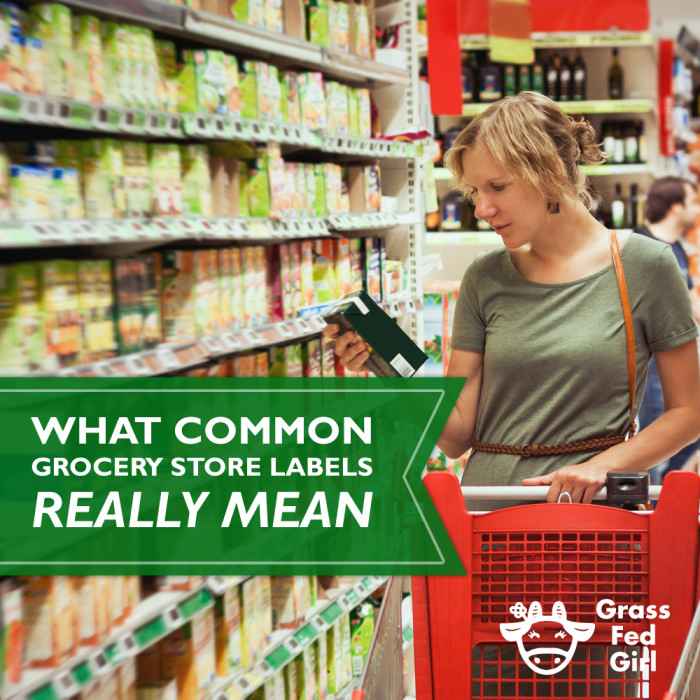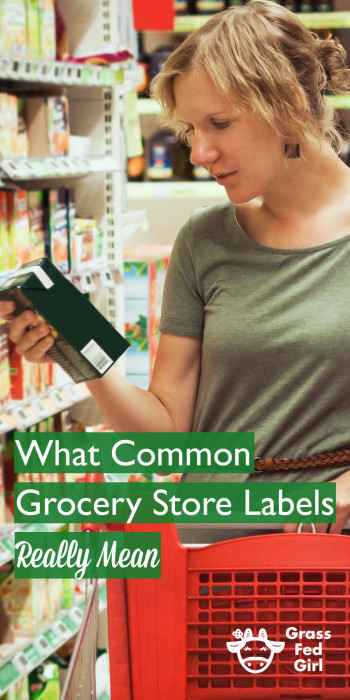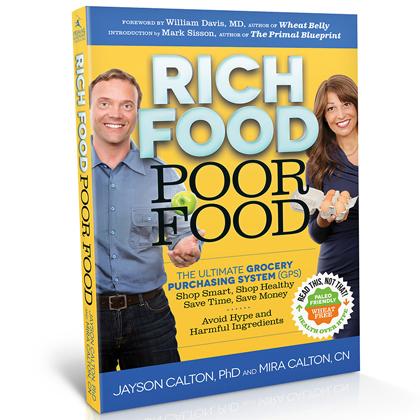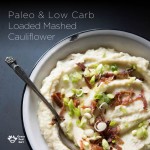 Labels can be very confusing while shopping at the grocery store and it take a bit of education to become a savvy shopper. Don’t worry it is not your own fault if you are trying to follow a healthy eating plan becasue the marketing is not on our side. It is a combination of word gymnastics that takes some self study to clear up. In this post I take the most common labels and terms at the market and explain them in simple terms.
Labels can be very confusing while shopping at the grocery store and it take a bit of education to become a savvy shopper. Don’t worry it is not your own fault if you are trying to follow a healthy eating plan becasue the marketing is not on our side. It is a combination of word gymnastics that takes some self study to clear up. In this post I take the most common labels and terms at the market and explain them in simple terms.
Understanding Nutrition Facts and Labels when Choosing Healthy Foods:
Organic: This label means free a food of fertilizers, pesticides, genetic modification and irradiation. Many experts believe that pesticides and fertilizers can build up in our systems and create detoxification problems that can lead to cellular dysfunction. Genetic modification is a new process that started in the mid 1990’s so we are really the first generation to be guinea pigs for these new crops. The heft of this label is always being eroded so make sure to stay up to date. Also state certifications such a CCOF is more strict than USDA. Also be aware that processed foods are allowed to be labeled organic but still have a small percentage of non-organic ingredients. Read more info in my article here.
Pesticide free: This word has no regulation but probably better than nothing. It is good to get to know a local farmer who can tell you what their practices are. Many farmers do not get certified organic because of the expense but do use similar methods of growing and harvesting.
Cage free: This term is usually used for chicken but it is an unregulated term that basically means there is no cage. It is a little more humane but does not mean the chickens have access to outdoor, bugs or sunshine which are essential for healthy eggs and meat. Chickens that are cage free will still live in an overcrowded barn and may be subject to clipped beaks with overdoses of antibiotics to stay healthy.
Wild caught: This label means the fish were born in a hatchery but then was caught in the wild. It could mean that the fish was eating Gmo’s during the first months of life and live in an overcrowded conditions. This doesn’t seem so bad but with gmo salmon approval on the docket I would be leery of this label and keep abreast of changes coming down the pike.
Wild: This means that a fish was born in the wild and caught in the wild. This is good because it means that fish were not fed genetically grains or antibiotics because of overcrowded aquaculture conditions. One of the main reasons people at fish is to get essential fats called omega-3s but farmed fish has considerably less omega-3 and is often died with food coloring to look the way wild counterparts would. Another reason to choose wild is that fish farms can be unsustainable and cause destruction of land and pollute water.
Sustainably farmed fish: This can mean that there is less environmental damage from the farming or that the fish are not fed antibiotics. Sometimes this label is more focused on environmental aspects than whether or not the fish is actually nutrient dense. Of course it is important to make choices about seafood ( or any food) based on sustainability but it is not the only factor to consider. Be aware that it is possible to find both sustainable and wild fish. I usually stick with wild salmon from Alaska and sardines from the Pacific or Morocco. Shellfish is one exception that is okay to buy farmed because they do not eat grains and can be farmed without a great impact to the environment. Also a new label I have been seeing is organic fish which leaves people scratching their heads. This means the feed fed to farmed fish is organic and that is better than nothing but the fish won’t be high in omega-3 and the farming practices can still cause damage to local environment.
Fat free: This lable is a no-brainer but people still fall for it. Scientist are now finding that sugar rather than natural fats are the culprit in cardiovascular inflammation. The problem is when processed food producers remove fat they often replace it with sugar or fillers such as cellulose which is wood pulp. The right kinds of fat are vital for brain function, energy and cellular function such as pastured animal fats and coconut or avocado.
Heart healthy: Most products claiming this are pushing vegetable oil margarines or liquid oils and the problem is that these fats are unstable and go rancid during processing that leads to an inflammatory reaction in the body that has been established as risk factor for future cardiovascular issues. Many of these polyunsaturated fats were created in the rally 1900s during times of famine or war but soon became a profitable commodity. It is best to stick with less processed and more traditional fats such as coconut oil, butter or beef tallow.
Rbst free: This is a growth hormone that was developed by Monsanto to increase milk output from cattle. It has a shaky safety record which led to even Walmart shunning the milk. It seems that consumer outcry has put the nail in the rbst coffin but be aware it is still used. The best way to avoid it is to buy organic dairy products.
Omega-3 eggs: This is when chickens are fed flax seed meal to increase omega : contender the problem is that flax is poorly assimilated in chickens and humans into useable omega 3. The best way for poultry to have more omega 3 is to feast on bugs and worms which is their natural diet. Another reason eggs and chicken has a poor ratio of omega is that they are fed corn which creates and imbalance of healthy fat in their skin and meat. Another big issue issue is that chickens need sunlight for vitamin d which is a cofactor in balanced omega 3 in farm animals.
Gmo free/ non-gmo: This is a voluntary label that is not regulated. It means that the food is not contaminated with bacteria and viruses that were created in a lab which have not been tested for safety. The food safety industry does not recognize the possible dangers of these new organisms pose on human health because regulations are largely influenced by Officials that have ties with biotechnology companies. To protect yourself choose organic and look for the non-gmo verified lable which is an independent organization that helps consumers. You can also avoid the most commonly genetically modified crops such as corn, soy and canola/ rapeseed. More detailed info in my article here.
Whole grains: Since the 1990’s we have been sold on the idea that whole grains are heart healthy which has played out in all time record high levels of heart disease. The problem with whole grains is complex and has several facets. One being that they are hard to digest because grains have an outer layer that is indigestible which causes the gut lining to become irritated. This leads to nutrient deficiencies from malabsorption. Nutrient deficiencies such as lack of magnesium and b vitamins can lead to heart problems, for example. Another issue is that whole grains still contain a great deal of insulin spiking sugar that over time can contribute to type 2 diabetes a leading risk factor that contributes to heart disease and is very damaging on its own.
Antibiotic free: This is a good label to see and is regulated. The only problem is that this does not mean the animal was grass fed, had access to sunlight or fed organic feed. It is better than nothing if you can only find this label then get it but hopefully you can seek out better sources of meat when you find a locally sourced farm.
Hormone free: A good label but chicken is not allowed to be fed hormones in the USA so it doesn’t mean much when it comes to fowl. Beef on the other hand is much healthier when it comes with a no hormone label. Hormones fatten cattle up faster so they can be brought to market more quickly. These added hormones can contribute to human hormone dysregulation such as excessive estrogen that contribute to obesity and other health problems in humans.
Trans fat free: It seems that people have accepted that trans fats are not healthy but what many people don’t get is that most polyunsaturated fats such as canola and soybean oil become rancid when they are processed at high heats. To make these factory made oils there is not any other way to produce them without high heats or by adding degrading solvents. So even before they hit the shelf they are oxidized, creating free radical damage when ingested. Another trick manufactures use is to lower the serving size to be very small so that labels can be say no trans fat which is a total untruth. When looking for a liquid oil choose olive oil or avocado oil.
Grass Fed: This sounds very appealing and always makes me happy to see it on a package of meat but the problem is that all cows are grass fed for a portion of their lives but then are usually transported to a feed lot for fattening up before slaughter. Grass fed cows are much higher in CLA that has been highly studied for cancer prevention. Everyday that livestock eats grains the beneficial fats decrease and the meat becomes higher in inflammatory fats. The only way to get the best meat is to look for the label of 100% grass fed in addition to organic. USDA does have a grass fed program but it has to have both the grass fed and USDA label. Goats and lamb are also a great source of healthy meat and fats that are often grass fed. Look for a local farmer to get to know what your meat is eating and read my other article here about meat sourcing.
Natural: there is no regulation on this term so don’t take it very seriously. Many times it written on food that is genetically modified which really rubs me the wrong way. Foods with this label can be full of sugar and rancid fats so when looking for something natural try something without labels for best results. Conventional meat is very often called natural but it is fed gmo corn and soy while being inoculated with fat promoting anti-biotic which doesn’t sound very natural to me.
Farm fresh: Often this is portrayed through pictures on the box of packages but it is often far from the truth. Don’t let glossy marketing fool you. Really get to know a local farmer by visiting your local farmers market or choose organic meat, eggs and produce at your supermarket when local sources are unavailable.
Gluten free: This is usually on food that means it is free of barley oats, wheat and rye (BROW) which contains the hard to digest gluten protein. This is a great lable if you are a celiac and truly allegic to gluten but often this lable leads people to believe that these foods are healthy and nothing can be further from the truth. Gluten free food like all packaged food can be jammed with sugar, artificial colors, flavors and adulterated fats. Gluten free cheats can be a welcome treat for someone on a paleo diet but should not be consumed more than a special occasion. Gluten free bread is often made with ingredients that the gut mistakes as the same as gluten especially during a healing phase, read more in my article about becoming grain free here. When looking for treats try making your own and follow my chocolate chip cookie recipe or my bread recipes.
A great book on this subject by my friends the Caltons is here:
Are there any more labels that you need decoding? Leave them in the comments and I will add to this article or write a part 2.

Sources:
http://www.helpguide.org/articles/healthy-eating/organic-foods.htm
http://animalwelfareapproved.org/wp-content/uploads/2013/04/Food-Labelling-for-Dummies-screen-v9-041013.pdf
http://www.westonaprice.org/health-topics/trans-fat-labeling/
http://www.cbsnews.com/news/what-does-natural-really-mean-on-food-labels/
http://ohsnapletseat.com/2013/04/01/different-types-of-eggs/
http://www.hobbyfarms.com/farm-marketing-and-management/6-misleading-food-labels.aspx
http://www.nationalchickencouncil.org/about-the-industry/chickopedia/
http://blogs.usda.gov/2012/03/22/organic-101-what-the-usda-organic-label-means/
http://www.foodandwaterwatch.org/food/consumer-labels/labels-that-tell-you-a-little/
http://www.babycenter.com/404_whats-the-difference-between-organic-and-pesticide-free-food_11803.bc
http://lifehacker.com/5941881/what-does-organic-really-mean-and-should-i-buy-it
http://www.wisegeek.org/what-does-rbst-free-mean.htm
http://www.webmd.com/food-recipes/egg-types-benefits-facts




